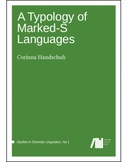Explore

A typology of marked-S languages
Corinna Handschuh
2014
0 Ungluers have
Faved this Work
Login to Fave
Case-systems all over the world exhibit striking similarities. In most lan-guages intransitive subjects (S) receives less overt marking than one of thetwo transitive arguments (agent-like A or patient-like P); the other one ofthese two arguments is usually encoded by the same form as S. In somelanguages the amount of overt marking is identical between S, A, and P.But hardly ever does the S argument receive more overt marking than Aor P. Yet there are some languages that do not follow this general pattern.This book is about those languages that behave differently, the marked-Slanguages.Marked-S languages are well-known to be found in East Africa, wherethey occur in two different language families, Afro-Asiatic and Nilo-Sa-haran. They can also be found in North-Western America and the Pacificregion. This book is the first investigation of marked S-languages thattreats the phenomenon on a global scale.The study examines the functional distribution of the two main case-forms, the form used for S (S-case) and the case-form of the transitive ar-gument which receives less marking (the zero-case). It offers a very fine-grained perspective considering a wide range of constructions. The con-texts in which the case-marking patterns are investigated include nom-inal, existential and locational predication, subjects in special discoursefunction (e. g. focused constituents), subjects of passives and dependentclauses, as well as the forms used for addressing someone (vocative form)and for using a noun in isolation (citation form).Apart from the functional distribution of case forms, the formal meansof marking are also considered. The main focus is on the synchronic de-scription and comparison of marked-S languages, but historical explana-tions for the unusual case-marking pattern are also discussed.
This book is included in DOAB.
Why read this book? Have your say.
You must be logged in to comment.
Rights Information
Are you the author or publisher of this work? If so, you can claim it as yours by registering as an Unglue.it rights holder.Downloads
This work has been downloaded 341 times via unglue.it ebook links.
- 172 - pdf (CC BY) at OAPEN Library.
Keywords
- Accusative case
- alignment
- argument structure
- case-marking
- grammatical case
- Language
- Linguistics
- marked absolutive
- marked nominative
- Predicate (grammar)
- Relative clause
- thema EDItEUR::C Language and Linguistics::CF Linguistics
- typology
Links
DOI: 10.26530/OAPEN_533871Editions

